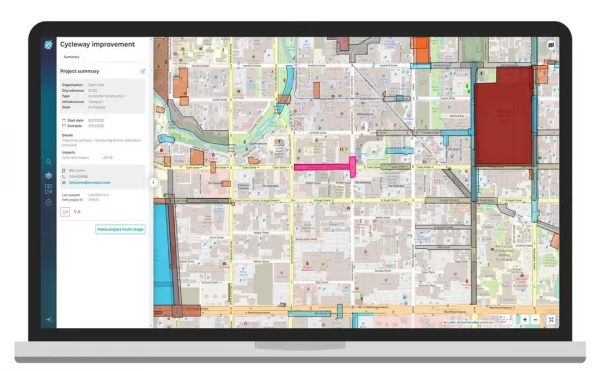Background
The National Forward Works Viewer (NFWV) was created in response to the rebuild after the Christchurch earthquake in 2011. The earthquakes destroyed parts of the city, and as part of significant work was undertaken as part of the recovery. This required coordination by multiple agencies working on the Christchurch rebuild to make work more efficient whilst reducing inconvenience to businesses and the public. The NFWV tool creates a single, integrated view of the recovery works. The initial roll-out of the Forward Works Viewer is estimated to have saved over $15 million in its first 18 months of use through shared roading works, traffic management and trenching, and reduced project management costs for coordinating agencies.
Opportunity
Before the NFWV existed, no platform enabled organisations to share their intentions in the road corridor. Resulting in issues occurring where one agency would apply for a traffic permit to upgrade their water pipes, and the following month, a different organisation may apply for a permit to replace their fibre cabling. Then, the road would have to be dug up twice instead of working simultaneously if both organisations knew each other’s intentions.
The Forward Works Viewer provides a single integrated view of multiple organisations' planned works, enabling them to undertake a ‘dig-once’ approach and sequence projects more efficiently. By all organisations publishing their intentions in the road corridor, it provides visibility on planned works and enables ease of conversations to happen between agencies. The collaboration between agencies saves time and money, reducing the inconvenience to businesses and the public from roadworks. Plus, collaborating on work opportunities means less resource waste and pollution.
The original Forward Works Viewer needed an overhaul in performance, functionality, and visuals to make it easier for all agencies and councils to use and navigate. It was built in haste to serve the immediate function of collaboration after the earthquake and not with a long-term view in mind. But, after using the tool post-earthquake it was recognised for its usefulness as a business-as-usual planning tool, and other councils began to use it.
The Product Owner, Open Plan, was passionate about the tool being built on open-source technology to free the platform of any proprietary licensing and the open standards guaranteed interoperability for future development. It also fits well with the new home of the FVW - a software foundation called the Digital Built Aotearoa Foundation - a not-for-profit charitable organisation formed to encourage collaboration and knowledge sharing from lessons learned to enable and improve infrastructure resilience throughout Aotearoa.
Catalyst was brought on board to rebuild the Forward Works Viewer at the end of 2021, and the new tool launched in April 2023.
The Catalyst team was working with complicated data sets, and the logic around the clashes and opportunities in the tool was complex. The data migration from the old system required an incredible amount of work to ensure the developers could pull everything across and redesign the new site.
Solution
The Catalyst team used the map-based tool GIS Core to rebuild the National Forward Works Viewer.(external link) Catalyst GIS Core is cloud-native and as-a-service, with:
- updates,
- monitoring,
- backups,
- and disaster recovery included.
It is built on open standards for interoperability with other software and is a fast, stable, reliable, and cost-effective spatial data platform. GIS Core is Catalyst’s in-house product, giving us full control and full customisation of everything that needs doing rather than trying to integrate it with a third-party system.
A user can log into the Forward Works Viewer system and see a map of all planned works in the area they are looking at, coloured by infrastructure type. Each project has a dedicated project summary page which details high-level information such as:
- the project name,
- a brief description,
- start and end dates,
- and the contact details of the project manager.
Additionally, the system generates a list of clashes (a project happening in the same place at the same time) and opportunities (a project happening in the same place but at a different time). Because of this, users can communicate with the other project managers to either reschedule their project or to work together. Users can add a project manually into the system, or projects can be bulk uploaded from other data sources or ingested via an API from a project management system.
Plus, Forward Works Viewer can help with event planning and coordination. For instance, loading the event into Forward Works Viewer the streets can be closed off, and maintenance scheduled around the marathon.
The tool can also ingest additional geospatial information in the form of contextual layers. So layers such as sites of cultural significance, assets, haulage routes and public transport routes can be laid over the project information to improve the knowledge of the area.
“It allows users to upload their planned work programmes to one central map, accessible to different organisations, creating a single authoritative repository of mapped forward works programmes,” says Adam Pantlin, Catalyst delivery lead.
There are now councils signed up all across the country, including Wellington City Council, Queenstown Lakes District Council, and Auckland Transport, as well as construction companies, contractors, and subcontractors.
The platform saves councils and contractors money and time and is also more sustainable. Collaborating on projects saves huge amounts of resources and reduces the amount of pollutants released into the atmosphere, soil, and waterways. By enabling road construction companies to collaborate around the timing of their projects.
The National Forward Works Viewer was originally developed in 2013, with input from LINZ(external link) (Land Information New Zealand), CERA(external link) (the Canterbury Earthquake Recovery Authority), CCDU(external link) (the Christchurch Central Development Unit), CTOC(external link) (the Christchurch Transport Operations Centre) and SCIRT(external link) (the Stronger Canterbury Infrastructure Rebuild Team).



